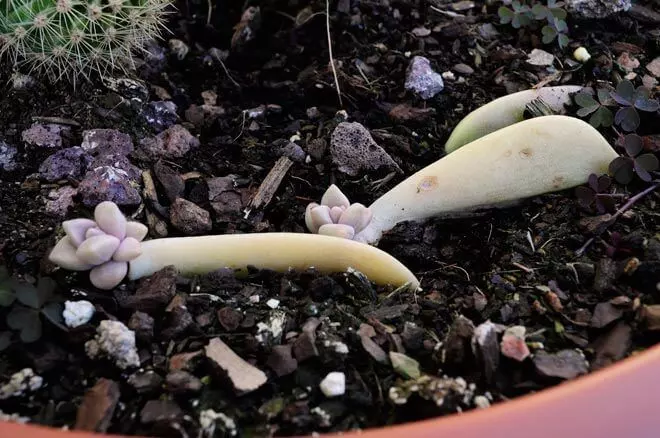Do you like succulent plants? If so, the “Graptopetalum paraguayense“, known as Graptopetalum, mother-of-pearl plant, or ghost plant cannot be missing in your collection. Its leaves are very decorative. They are arranged in a kind of rosette, which is almost a work of art. Make a place for it on your terrace, you will not regret it.
Table of Contents
Description
Graptopetalum paraguayense does not come from Paraguay. It is a crassulacea native to Mexico, as is the echeveria or alabaster rose.
Both have other similarities, beyond their kinship and origin, to the point that they can become hybridized and are often confused.
Graptopetalum paraguayense has fleshy leaves, obovate in shape, but ending in a point. Don’t worry, they won’t prick you! The dominant color is gray or bluish-green, although at the apex they tend to be pink. They are all covered by a kind of wax that should not be removed, it protects them from direct sunlight.
They are grouped forming showy rosettes, like the echeveria. But, unlike the latter, they are less tightly packed and held by long stems, often hanging.
At the end of winter, it begins to prepare its flowers, which will not open until early spring. They will be small white flowers with triangular petals, similar to five-pointed stars.
- 『𝗜𝗡𝗖𝗟𝗨𝗗𝗘𝗦』 (1) Beautiful live Ghost Plant plant fully rooted. It matures to a shrub-like mounding form. The stems or joints attach to pads and can create quite a thicket over time. This plant also looks stunning in hanging baskets. Its leaves are tiny, needle-like and lime green in color and they spread freely, forming a beautiful mat. This is a colorful, succulent perennial with up to 6 inches (15 cm) wide rosettes, holding thick, triangular, pointed, flat leaves
- 『𝗙𝗟𝗢𝗪𝗘𝗥𝗦』The flowers are 0.8 inch (2 cm) wide and white in color, with small red specks.
- 『𝗗𝗜𝗙𝗙𝗜𝗖𝗨𝗟𝗧𝗬』 Relatively easy, great for beginners.
Uses of this Succulent
Thanks to its stems, the Graptopetalum paraguayense will look fantastic in any of your pots. As the rosettes grow, they will hang over the edges like a waterfall.
Place the pot on the wall, suspended from the ceiling, or leave it on the floor; it’s up to you!
Graptopetalum paraguayense is very suitable for terraces and balconies in Mediterranean or warm climates. It suits you for its originality and its tremendous resistance; it will hardly need water and very little care.
Graptopetalum paraguayense is equally suitable for the garden. If you plant it in a rockery area, it will expand by itself. Interesting solution…!
You should even grow it indoors, as long as it has enough light. Be careful with the heating.

Growing and Care Graptopetalum paraguayense
It tolerates both direct sun and half shade. In places with a lot of sunshine, if it is somewhat protected, much better; you will give some respite.
For cultivation in pots, use wide models rather than deeper ones. Graptopetalum paraguayense does not need large roots. Use loose soil that helps keep them well aerated; they hate waterlogging. Substrates for cacti and succulents can help you achieve this (Order it here).
I have already told you that it is a tough plant, however, you must be careful with water. Like other succulent plants, it is sensitive to root asphyxia and fungus; be careful with watering!
In summer is when it will demand more water, but don’t overdo it: once a week will be enough in most cases (even in a pot). In winter you will hardly have to hydrate (nothing, if it is planted in the ground).
And since we are talking about winters… this is another issue to consider: the cold, to be exact. With strong or repeated frosts move your plant indoors; it will not withstand them.
To finish with its care, one last tip: try not to wet or touch the leaves too much or you will damage the waxy layer that protects them from the sun. They can even fall off quite easily. Do not panic, this is normal.
Pests And Diseases Graptopetalum paraguayense
Root rot from over-watering is the worst problem you can encounter. Beware of overwatering or your plant will die.
Given the worst-case scenario, it’s also worth remembering that mealybugs like cacti and other succulent plants. The Graptopetalum paraguayense is no exception.
You should fight them with Azadirachtin (neem oil), for example, when the pest is widespread. If it is a localized plant, it will be enough to remove them manually or at most use a brush dipped in alcohol.

How to Propagate Graptopetalum paraguayense
Earlier I told you that the leaves of the Graptopetalum paraguayense sometimes detach just by touching them. Far from being a disadvantage, it is perhaps even an evolutionary advantage, due to the ease with which they can root.
New specimens are often formed from the fallen leaves, with identical characteristics to the mother plant. This is an asexual form of reproduction that you can take advantage of to make cuttings.
We recommend using a rooting hormone to be more successful in the propagation of this succulent (Order it here).
I am especially interested that you observe that not only the leaves are useful, you can also use stems, and “if any” shoots with some root. In my case, the idea is a centerpiece for the terrace, but you can even place them directly on the ground in your garden.


